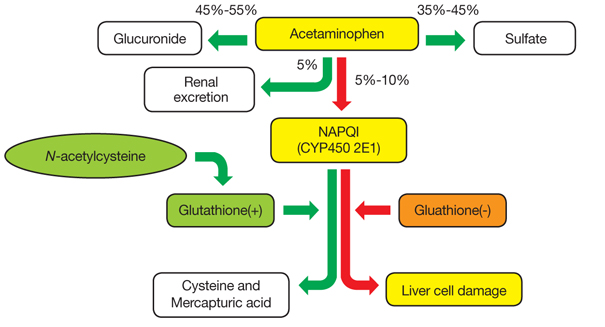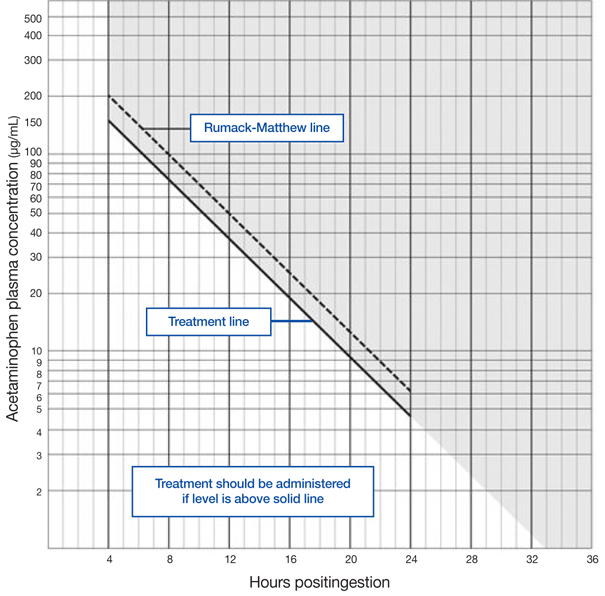J Korean Med Assoc.
2013 Dec;56(12):1067-1075. 10.5124/jkma.2013.56.12.1067.
Antidote for acetaminophen poisoning: N-acetylcysteine
- Affiliations
-
- 1Department of Emergency Medicine, Chonnam National University School of Medicine, Gwangju, Korea.
- 2Department of Emergency Medicine, Yonsei University School of Medicine, Seoul, Korea. edksh@yumc.yonsei.ac.kr
- KMID: 1783721
- DOI: http://doi.org/10.5124/jkma.2013.56.12.1067
Abstract
- N-acetylcysteine (NAC) is widely recognized as the antidote of choice for acetaminophen overdose. Acetaminophen is a commonly used analgesic and antipyretic agent, and its use is one of the most common causes of poisoning worldwide. Acetaminophen toxicity may occur acutely when supratherapeutic amounts are ingested purposefully or unintentionally. Liver failure may occur in severe toxicity. However, if treated early, patients with acetaminophen poisoning generally recover uneventfully. Acetaminophen is metabolized to N-acetyl-p-benzoquinone imine (NAPQI), which is detoxified by conjugation with glutathione. In overdose, hepatic stores of glutathione are depleted and NAPQI binding to hepatocytes induces cell death and hepatic necrosis. NAC replenishes hepatic glutathione and may also act as a glutathione substitute, combining directly with the toxic metabolite. Intravenous NAC is indicated in patients who present with a history of acetaminophen overdose within the previous 8 to 10 hours, patients unable to tolerate oral NAC, and patients who present with evidence of fulminant hepatic failure. However, caution should be used in patients who have experienced previous hypersensitivity or anaphylactoid reactions to intravenous NAC, as well as in patients with asthma. The most common anaphylactoid reactions include rash, flushing, and bronchospasm. Adults should receive 150 mg/kg administered for 45 minutes, followed by 50 mg/kg administered for 4 hours, followed by 100 mg/kg administered for 16 hours. The total dose is 300 mg/kg delivered over 21 hours. Additionally, caution should always be used when intravenous NAC is prescribed and the amount of diluent is calculated. Monitoring of patients with a should include repeated neurologic and hemodynamic assessment.
MeSH Terms
Figure
Reference
-
1. Lee WM. Acetaminophen and the U.S. Acute Liver Failure Study Group: lowering the risks of hepatic failure. Hepatology. 2004; 40:6–9.
Article2. Bronstein AC, Spyker DA, Cantilena LR Jr, Rumack BH, Dart RC. 2011 Annual report of the American Association of Poison Control Centers' National Poison Data System (NPDS): 29th annual report. Clin Toxicol (Phila). 2012; 50:911–1164.
Article3. Kim HJ, Kim YW, Kim H, Park CB, So BH, Lee KR, Lee KW, Lee KW, Lee SW, Lee JY, Cho GC, Cho J, Chung SP. Comparison between emergency patient poisoning cases and the Tox-Info System Database. J Korean Soc Clin Toxicol. 2012; 10:8–14.4. Kim J. Tylenol syrups for children recalled. The Korea Times. 2013. 04. 23.5. US Food and Drug Administration. FDA warns of rare acetaminophen risk [Internet]. Silver Spring: US Food and Drug Administration;2013. cited 2013 Nov 12. Available from: http://www.fda.gov/forconsumers/consumerupdates/ucm363010.htm.6. Mitchell JR, Jollow DJ, Potter WZ, Gillette JR, Brodie BB. Acetaminophen-induced hepatic necrosis. IV. Protective role of glutathione. J Pharmacol Exp Ther. 1973; 187:211–217.7. Prescott LF, Park J, Ballantyne A, Adriaenssens P, Proudfoot AT. Treatment of paracetamol (acetaminophen) poisoning with N-acetylcysteine. Lancet. 1977; 2:432–434.
Article8. Chung SP, Kim SH, Lee HS. Acetaminophen poisoning. J Korean Soc Clin Toxicol. 2008; 6:1–8.9. McGilveray IJ, Mattok GL, Fooks JR, Jordan N, Cook D. Acetaminophen II. A comparison of the physiological availabilities of different commercial dosage forms. Can J Pharm Sci. 1971; 6:38–42.10. Bannwarth B, Netter P, Lapicque F, Gillet P, Pere P, Boccard E, Royer RJ, Gaucher A. Plasma and cerebrospinal fluid concentrations of paracetamol after a single intravenous dose of propacetamol. Br J Clin Pharmacol. 1992; 34:79–81.
Article11. Xu JJ, Hendriks BS, Zhao J, de Graaf D. Multiple effects of acetaminophen and p38 inhibitors: towards pathway toxicology. FEBS Lett. 2008; 582:1276–1282.
Article12. Patten CJ, Thomas PE, Guy RL, Lee M, Gonzalez FJ, Guengerich FP, Yang CS. Cytochrome P450 enzymes involved in acetaminophen activation by rat and human liver microsomes and their kinetics. Chem Res Toxicol. 1993; 6:511–518.
Article13. Mitchell JR, Jollow DJ, Potter WZ, Davis DC, Gillette JR, Brodie BB. Acetaminophen-induced hepatic necrosis: I. role of drug metabolism. J Pharmacol Exp Ther. 1973; 187:185–194.14. Ekins BR, Ford DC, Thompson MI, Bridges RR, Rollins DE, Jenkins RD. The effect of activated charcoal on N-acetylcysteine absorption in normal subjects. Am J Emerg Med. 1987; 5:483–487.
Article15. Mazer M, Perrone J. Acetaminophen-induced nephrotoxicity: pathophysiology, clinical manifestations, and management. J Med Toxicol. 2008; 4:2–6.
Article16. Lee JY, Gil HW, Yang JO, Lee EY, Hong SY. A case of acute renal failure induced by acetaminophen intoxication. Korean J Med. 2011; 80:348–351.17. Makin A, Williams R. The current management of paracetamol overdosage. Br J Clin Pract. 1994; 48:144–148.18. Lee WM. Acute liver failure. Dallas: Cambridge University Press;2000.19. Flanagan RJ, Mant TG. Coma and metabolic acidosis early in severe acute paracetamol poisoning. Hum Toxicol. 1986; 5:179–182.
Article20. Rumack BH, Matthew H. Acetaminophen poisoning and toxicity. Pediatrics. 1975; 55:871–876.
Article21. Wikipedia. Rumack-Matthew nomogram [Internet]. San Francisco: Wikimedia Foundation;cited 2013 Nov 12. Available from: http://en.wikipedia.org/wiki/Rumack-Matthew_nomogram.22. Smilkstein MJ, Douglas DR, Daya MR. Acetaminophen poisoning and liver function. N Engl J Med. 1994; 331:1310–1311.
Article23. Prescott LF, Illingworth RN, Critchley JA, Proudfoot AT. Intravenous N-acetylcysteine: still the treatment of choice for paracetamol poisoning. Br Med J. 1980; 280:46–47.
Article24. Rumack BH, Peterson RC, Koch GG, Amara IA. Acetaminophen overdose: 662 cases with evaluation of oral acetylcysteine treatment. Arch Intern Med. 1981; 141(3 Spec No):380–385.
Article25. Dart RC, Erdman AR, Olson KR, Christianson G, Manoguerra AS, Chyka PA, Caravati EM, Wax PM, Keyes DC, Woolf AD, Scharman EJ, Booze LL, Troutman WG. American Association of Poison Control Centers. Acetaminophen poisoning: an evidence-based consensus guideline for out-of-hospital management. Clin Toxicol (Phila). 2006; 44:1–18.
Article26. Buckley NA, Whyte IM, O'Connell DL, Dawson AH. Activated charcoal reduces the need for N-acetylcysteine treatment after acetaminophen (paracetamol) overdose. J Toxicol Clin Toxicol. 1999; 37:753–757.
Article27. Daly FF, Fountain JS, Murray L, Graudins A, Buckley NA. Panel of Australian and New Zealand clinical toxicologists. Guidelines for the management of paracetamol poisoning in Australia and New Zealand: explanation and elaboration: a consensus statement from clinical toxicologists consulting to the Australasian poisons information centres. Med J Aust. 2008; 188:296–301.28. Prescott LF. Paracetamol: past, present, and future. Am J Ther. 2000; 7:143–147.29. Heard KJ. Acetylcysteine for acetaminophen poisoning. N Engl J Med. 2008; 359:285–292.
Article30. Hayes BD, Klein-Schwartz W, Doyon S. Frequency of medication errors with intravenous acetylcysteine for acetaminophen overdose. Ann Pharmacother. 2008; 42:766–770.
Article31. Chae HJ, Rhee NG, Kim HJ, You JS, Chung SP, Lee HS. Oral vs. Intravenous administration of N-acetylcysteine in the acetaminophen poisoning. J Korean Soc Clin Toxicol. 2012; 10:97–102.32. Perry HE, Shannon MW. Efficacy of oral versus intravenous N-acetylcysteine in acetaminophen overdose: results of an open-label, clinical trial. J Pediatr. 1998; 132:149–152.
Article33. Bebarta VS, Kao L, Froberg B, Clark RF, Lavonas E, Qi M, Delgado J, McDonagh J, Arnold T, Odujebe O, O'Malley G, Lares C, Aguilera E, Dart R, Heard K, Stanford C, Kokko J, Bogdan G, Mendoza C, Mlynarchek S, Rhyee S, Hoppe J, Haur W, Tan HH, Tran NN, Varney S, Zosel A, Buchanan J, Al-Helial M. A multicenter comparison of the safety of oral versus intravenous acetylcysteine for treatment of acetaminophen overdose. Clin Toxicol (Phila). 2010; 48:424–430.
Article34. Zyoud SH, Awang R, Syed Sulaiman SA, Sweileh WM, Al-Jabi SW. Incidence of adverse drug reactions induced by N-acetylcysteine in patients with acetaminophen overdose. Hum Exp Toxicol. 2010; 29:153–160.
Article35. Pakravan N, Waring WS, Sharma S, Ludlam C, Megson I, Bateman DN. Risk factors and mechanisms of anaphylactoid reactions to acetylcysteine in acetaminophen overdose. Clin Toxicol (Phila). 2008; 46:697–702.
Article36. Sandilands EA, Bateman DN. Adverse reactions associated with acetylcysteine. Clin Toxicol (Phila). 2009; 47:81–88.
Article37. Mohammed S, Jamal AZ, Robison LR. Serum sickness-like illness associated with N-acetylcysteine therapy. Ann Pharmacother. 1994; 28:285.
Article38. Lu HC, Shih RD, Marcus S, Ruck B, Jennis T. Pseudomethemoglobinemia: a case report and review of sulfhemoglobinemia. Arch Pediatr Adolesc Med. 1998; 152:803–805.39. Bailey B, McGuigan MA. Management of anaphylactoid reactions to intravenous N-acetylcysteine. Ann Emerg Med. 1998; 31:710–715.
Article40. Elms AR, Owen KP, Albertson TE, Sutter ME. Fatal myocardial infarction associated with intravenous N-acetylcysteine error. Int J Emerg Med. 2011; 4:54.
Article41. Bailey B, Blais R, Letarte A. Status epilepticus after a massive intravenous N-acetylcysteine overdose leading to intracranial hypertension and death. Ann Emerg Med. 2004; 44:401–406.
Article42. Heard K, Schaeffer TH. Massive acetylcysteine overdose associated with cerebral edema and seizures. Clin Toxicol (Phila). 2011; 49:423–425.
Article43. Marzullo L. An update of N-acetylcysteine treatment for acute acetaminophen toxicity in children. Curr Opin Pediatr. 2005; 17:239–245.
Article44. Wilkes JM, Clark LE, Herrera JL. Acetaminophen overdose in pregnancy. South Med J. 2005; 98:1118–1122.
Article
- Full Text Links
- Actions
-
Cited
- CITED
-
- Close
- Share
- Similar articles
-
- Acetaminophen Poisoning
- The Clinical Use of the Plasma Acetaminophen Halflife in NAC-treated Acetaminophen Overdose
- N-acetylcysteine for Acetaminophen Poisoning Without Hepatotoxicity: the Effect on the Prothrombin Time
- Up-to-date treatment of acetaminophen poisoning
- Predicting serum acetaminophen concentrations in acute poisoning for safe termination of N-acetylcysteine in a resource-limited environment



